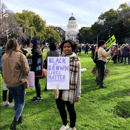Trigger warning: sexual assault, sexual harassment, rape
While many of us can resonate “sexual assault,” on many occasions, there is confusion in identifying clear-cut definitions of what falls within sexual violence. We must understand where the lines are drawn when it comes to sexual violence if we want to find justice for those who have experienced it.
It’s important to understand that sexual violence is more than rape. There are various types of sexual assault that are sometimes not explicitly defined. With rape being the biggest topic of sexual assault, it is easy for it to be the only type the public pays attention to. The National Intimate Partner and Sexual Violence Survey (NISVS) is a statistical reference that can help us understand the types of sexual violence and what both men and women experience on a national scale.
According to the NISVS 2010-2012 state report, five types of sexual violence were recorded: rape, penetration, sexual coercion: unwanted sexual contact, unwanted sexual contact, and non-contact unwanted sexual experiences. Sexual violence is a broad term that encompasses the different forms it may appear in. Rape is defined as any unwanted vaginal, oral, or anal penetration. There are three types of rape: completed alcohol, or drug, facilitated penetration, attempted or forced penetration, and completed forced penetration.
The NISVS state report found that 1 in 3 women experience contact sexual violence during her lifetime, and 1 in 6 men experience contact sexual violence in his life. Contact sexual violence includes any of the five types of sexual violence (rape, sexual coercion, being made to penetrate someone else, unwanted sexual contact, or non-contact unwanted sexual experiences).
The NISVS statistic proves that sexual violence is an issue that creates victims of all genders. Obama spoke on sexual assault in 2014 at a Council on Women and Girls stating, “This is not an abstract problem that goes on in other families or other communities, it affects every one of us. It’s about all of us: our moms, our wives, our sisters, our daughters, our sons.” This is everyone’s fight.
Image source: Pexels
Having described rape, here are brief definitions of the other four types:
Sexual coercion is any unwanted sexual penetration that happens after a person is pressured in a nonphysical way. This includes being threatened, feeling pressured by a person of authority, or lied to by someone in order for them to coerce you into having sex.
Being made to penetrate someone else is when the victim was made to, or there was an attempt to, make the victim sexually penetrate someone else without the victim’s consent because the victim was forced through violence, was threatened, or was otherwise unable to consent.
Unwanted sexual contact is exactly as it sounds: any non-consensual sexual experience that does not involve penetration. Groping, fondling, and grabbing fall into this category.
Non-contact unwanted sexual experiences don’t involve touching or penetration but include someone exposing their sexual body parts, or someone making a victim show their sexual body parts.
These are all forms of sexual assault.
The first step to finding justice for those who have been assaulted is by understanding what has happened to them and acknowledging that this can happen to anyone. This NISVS infographic sums up everything you should know.
I cannot speak for those that have gone through sexual violence, but I can say that new reports have become uncomfortably common nowadays. Now that we have created a safe space for people to confess what they’ve gone through (#metoo), many people have spoken up. Sexual assault has a long history that will likely continue on, but let’s hope we can continue to encourage each other to speak about any mistreatment.



